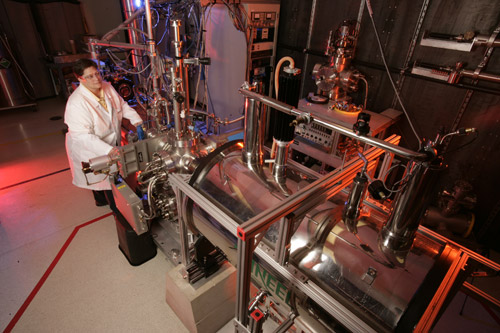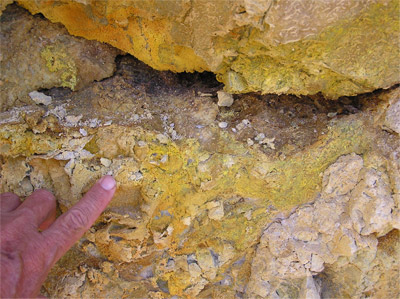[/caption][/caption]
For a geologist, looking inside a rock is essential to help determine the makeup and history of the rock sample. That’s why geologists have rock hammers, and also why the Mars Exploration Rovers, Spirit and Opportunity, have their Rock Abrasion Tool. For future missions to Mars, or even for a sample return mission, one of the main goals will be to look for signs of life, past or present, that might be hiding inside the rocks. Scientists are working on a new, simple technique for detecting biological and pre-biotic molecules that become trapped inside the minerals in rocks.
This new technique utilizes a laser-based optical and chemical imager or LOCI. A single laser shot vaporizes a small portion of the surface into individual ions. These pass through a mass spectrometer, which can identify each ion by how much mass and charge it has. The great thing about this technique is that the sample requires no preparation: just shoot and detect.
Previous techniques for required that the minerals be dissolved in a solution or mixed in with some other medium, which dilutes the sample and runs the risk of introducing contamination.

This procedure was tested on Earth using samples of the mineral jarosite. Jarosite is a yellowish-brown sulfate mineral containing iron, potassium and hydroxide. It is found in places around the world such as southern California beaches and volcanic fields in New Zealand. It forms only in the presence of highly acidic water.
In 2004, jarosite was discovered on Mars by the rover Opportunity. Scientists immediately recognized the find as clear evidence for past water on the red planet.
But there is something else about jarosite that makes it interesting. On Earth, for jarosite to form, oxidation of the rock must occur – usually the rock is pyrite (ferrous sulfide). And on Earth, the oxidation reaction is usually performed by certain “rock-eating” microorganisms.
Scientists say the rate of the jarosite formation would be extremely slow without microbes, as well as without the presence of water.
Whether jarosite can form without the assistance of these microbes is very difficult to say, since every corner of Earth is occupied by little bugs of some sort or another.
And yet, there remains the tantalizing possibility that jarosite on Mars exists because of some little, rock-eating microbes. If so, remnants of these organisms may be locked in the mineral. And there’s only one way to find out: look inside Mars rocks.
Right now, this method couldn’t be used on the next bigger Mars rover, the Mars Science Laboratory, which will hopefully launch in 2009. The LOCI instrument is just too big and too complex to use remotely, said David Beaty, chief scientist of the Mars Exploration Directorate at the Jet Propulsion Laboratory.
But it could be used on a sample return mission. But hopefully, scientists will be able to develop a smaller, simpler version to be used on future missions to look for signs of life in rocks on Mars.
Original News Source: Astrobiology Magazine


I’d say look inside the “Blueberries” that Opportunity found first. If there’s microbes there, that might explain the seasonal color/shade change that Slipher observed, along with Sinton’s spectrographic observations and Dollfus’ seasonal polarization change. According to a senior researcher, they cannot say whether the “blueberries” contain life or not based on Opportunity’s instruments…..it’s time to find out! Yes – it’s time for an “Imminent Discovery”
Good Luck Phoenix!
Surely ChemCam ( a Laser-Induced Breakdown Spectroscopy system) on the Mars Science Laboratory will have, at least, significant overlap in terms of scientific capability with this instrument, no?
I’m fully aware that the measurement being made is completely different, but when it comes down to it they are both designed to gauge the elemental and mineralogical composition of rocks such as those mentioned in the article…
I guess this method would be far better able to differentiate between different isotopes of the various substances detected than a LIBS, but still…